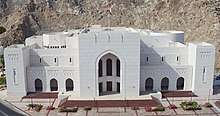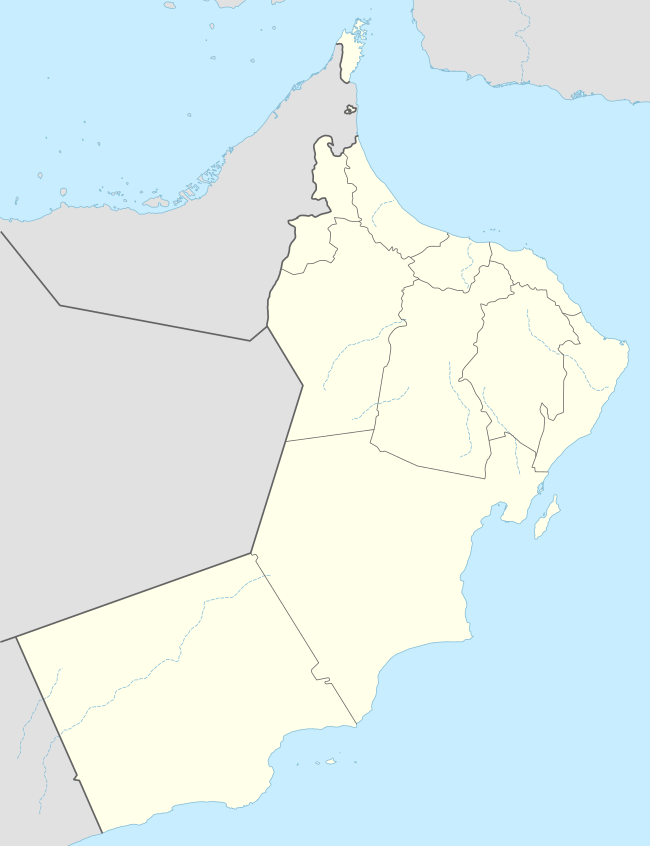National Museum (Oman)
The National Museum of the Sultanate of Oman, established by royal decree in 2013 and opened July 30, 2016,[1] is the Sultanate's flagship cultural institution, showcasing the nation’s heritage from the earliest human settlement in the Oman Peninsula some two million years ago through to the present day. As a national institution with global outreach, the museum is dedicated to ensuring that Oman’s cultural heritage is understood and appreciated not only within the Sultanate, but also internationally. Further, it aims to provide opportunities for cultural expression, innovation, and the transfer of traditional skills and knowledge from one generation to the next.[2]
 | |
 National Museum Location in Oman | |
| Established | 20 November 2013 |
|---|---|
| Location | Al Saidiya Street, opposite Al Alam Palace, Old Muscat, Oman |
| Coordinates | 23.6115826°N 58.5937595°E |
| Type | National museum |
| Director | Jamal Al Moosawi |
| Public transit access | Mwaslat bus no.4 LINE (RuwiـMatrahـMuscat) |
| Website | www |
The museum is located in the heart of Muscat in a purpose-designed building. The total area of the building is 13,700 square metres (147,000 sq ft), including 4,000 square metres (43,000 sq ft) allocated for 14 permanent galleries – The Land and the People Gallery, Maritime History Gallery, Arms and Armour Gallery, Aflaj Gallery, Currency Gallery, Prehistory and Ancient History Galleries, Splendours of Islam Gallery, Oman and the World Gallery, Intangible Heritage Gallery and Renaissance Gallery, among others.[3] A further 400 square metres (4,300 sq ft) are allocated for temporary exhibitions.
The National Museum houses 5,466 objects and offers 43 digital immersive experiences, a fully equipped Learning Centre, conservation facilities, an ultra-high definition cinema,[4] and discovery areas for children.[5] It features an integrated infrastructure for special needs and is the first museum in the Middle East to adopt Arabic Braille script for the visually impaired. The museum contains a voluminous collection of prehistoric metallic artefacts [6] It also houses the region’s first open-plan museum storage concept, where visitors can learn about the various processes that artefacts go through before they are put on display.
Board of Trustees of the National Museum
- His Excellency Salem bin Muhammad Al Mahrouqi - Ministry of Heritage and Culture, Chairman of the Board of Trustees
- Her Excellency Dr. Madiha bint Ahmed ash-Shibaniyyah - Minister of Education, Deputy Chairman of the Board of Trustees
- His Excellency Sayyid Badr bin Hamad al-Busaidi - Secretary General of the Ministry of Foreign Affairs - member
- His Excellency Dr. Hilal bin Ali al-Hinai - Secretary General of the Research Council - member
- His Excellency Dr. Hamad bin Muhammed ad-Dhoyani - Chairman of the National Records and Archives Authority - member
- Dr. Mounir Bouchenaki - Director of the Arab Regional Centre for World Heritage
- Mikhail Borisovich Piotrovskiy - Director General of the Hermitage Museum, Russia - member
Building and facilities
| Building and facilities | |
| Total plot area | 24000 m2 |
| Total building area | 13700 m2 |
| Total gallery area | 4000 m2 |
| Number of galleries | 14 |
| Permanent Galleries | The Land and the People
Maritime History Arms and Armour Civilisation in the Making Aflaj Currency Timeline Bat, al-Khutm and al-Ayn Land of Frankincense Prehistory and Ancient History Splendours of Islam Oman and the World The Renaissance Intangible Heritage |
| Other facilities | Learning Centre
Conservation Facilities Temporary Exhibitions Gallery Collections Gallery (Open Storage Concept) Café Gift Shop |
References
- Hasan, Deeba (26 July 2016). "#OmanPride: National Museum of Oman all set to open". Times of Oman.
- Sultanate of Oman, National Museum, 2015
- Sultanate of Oman, National Museum, Muscat, 2015
- y Pluse of Oman, 17 December 2015
- Sultanate of Oman, National Museum, Muscat, 2015
- Yule, P.‒Gernez, G. (eds.), Early Iron Age metal-working workshop in the Empty Quarter, Sultanate of Oman, Universitätsforschungen zur prähistorischen Archäologie, 316, Bonn, 2018.
External links
![]()